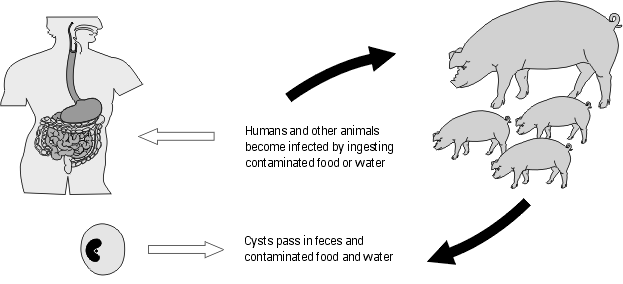| | Life cycle of Balantidium | How does Balantidium harm pigs? | How will I know my herd is infected? | Do other animals get Balantidium? | Can Balantidium harm people? | How is infection spread? | How can I prevent infection?
The disease balantidiasis is an example of a zoonotic waterborne infection. The protozoan causing the infection, Balantidium coli, is common in swine worldwide in warm and temperate climates, but is rarely reported in Canada.
Although there appears to be little risk of acquiring B. coli in Canada, producers should be aware of the disease and its effects on their animals and themselves.
The prevalence of balantidiasis in Canada is not known precisely since it is not a reportable disease in people, and few surveys have been conducted to determine its prevalence in swine.
Life Cycle of Balantidium
Balantidium coli is the largest protozoan that parasitizes man. Two stages occur (Figure 1).

Figure 1. Life cycle of Balantidium coli
The trophozoite stage is large, oval and covered with short cilia that allow it to swim in the large intestine. This motile stage measures 50 to 100 microns in length and 40 to 70 microns in width. Two nuclei are present, one large bean-shaped macronucleus and one small round micronucleus.
The second stage, the cyst stage, is responsible for transmitting the parasite to a new host. The cysts measure from 50 to 70 microns in diameter. Both cysts and trophozoites pass in the feces, but only the environmentally-resistant cyst can survive outside the body and contaminate food and water.
When the cyst is eaten, it "hatches" (excysts) in the host's intestine, releasing the motile form that begins to feed on cell fragments, starch grains and other organic matter.
How Does Balantidium Harm Pigs?
Balantidium is usually found as a harmless organism in pigs, but it can sometimes cause severe clinical and even fatal disease. B. coli can be found in all age categories of animals.
Some pigs experience moderate to severe diarrhoea, while others show no sign of disease. The difference between the acute and the symptomless pigs may indicate that different strains of the parasite are involved. Sows can shed many cysts thereby contaminating farrowing pens.
Many scientists believe Balantidium from pigs and humans are the same species. However, some pig strains of the parasite can be distinguished from human strains and are not infectious to humans.
How Will I Know My Herd is Infected?
Your veterinarian can do a routine microscopic examination of a fresh fecal sample to find the organism. Cysts are found in normal feces whereas trophozoites are found most often in watery feces.
Do Other Animals Get Balantidium?
Several species of Balantidium have been described including B. suis from pigs, B. caviae from guinea pigs and B. duodeni from frogs. Pigs appear to be the major reservoir of strains of B. coli found in humans.
Can Balantidium Harm People?
It is not known whether B. coli in pigs is identical to the species known from humans, and that is why their importance in the study of disease and prevention is not clear. Humans are apparently not susceptible to some pig strains of the parasite.
Some strains of Balantidium produce no sign of infection, while other strains may cause severe diarrhoea. As in pigs, the differences in clinical features may be the result of differences in host susceptibility to the parasite or differences in the virulence of particular strains of the parasite.
Most infected individuals show no symptoms. Others develop diarrhoea, nausea, vomiting, anorexia and headache. Recurrent diarrhoea may persist for weeks to months.
Balantidium rarely invades the intestine. When it does, it produces ulceration of the colon. Some of the ulcers may extend to the muscular layer of the intestine. Although the number of these cases is small, extra-intestinal disease can occur.
How is Infection Spread?
People become infected when they accidentally ingest cysts contaminating food or water. Domestic hogs probably serve as the most important reservoir host for human infection.
In areas where pigs are the main domestic animal, the prevalence of human infection can be high. Pig farmers, butchers or people working in slaughterhouses are particularly susceptible to infection.
Human infection is fairly rare in temperate areas, although once the infection is established, it can spread to others, particularly where poor environmental sanitation and personal hygiene are found.
How Can I Prevent Infection?
Overcrowded pens or barns and poor sanitation practices are some of the factors that can lead to the spread of Balantidium. Since the method of transmission is by ingesting infective cysts in contaminated food and water, preventative measures involve increased attention to personal hygiene and sanitation measures.
Prepared by:
Murray J. Kennedy, Ph.D.
Food Safety Division
Source: Agdex 655-11. February 2006. |
|